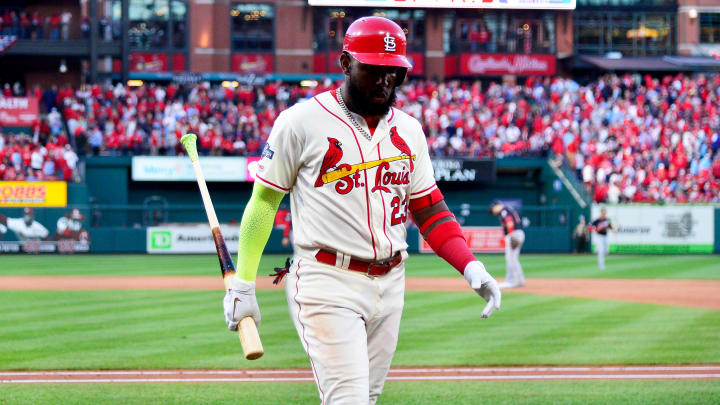Cardinals Bats Silenced Again as NLCS Chances Fall Dangerously Low

The 2019 Cardinals have not had a two-game stretch like this before.
Oh, they’ve had back-to-back losses; they’ve had a shutout followed by a one-run contest and vice versa. That, while rather rare, is not new. But they’ve never had their bats silenced quite as much as they have here—with just four hits and one run combined—two games into the NLCS. As Max Scherzer took a no-hit bid into the seventh on Saturday, just after Aníbal Sánchez put together his own on Friday, St. Louis fell behind 2-0 in the series, its bats conspicuously absent.
The Cardinals’ three hits and one run in Game 2 marked an improvement over their one-hit shutout from Game 1, but that doesn’t mean much. Their lowest combined hit total across back-to-back games this year—even from their lackluster first half—was seven. Here, in the first two games in the NLCS, it’s been four. That is, of course, a credit to the Nationals’ staff, particularly Sánchez and Scherzer, but it’s just as much a point of concern for the Cardinals.
Were it not for a misplayed ball by Nationals centerfielder Michael A. Taylor—an eighth-inning, two-out shot that fell over his head for a hit and ultimately led to the lone run for St. Louis—all these numbers would have been even more dismal. This is a Cardinals team that has been shut out just four times since July 1 (including Game 2 of the NLDS), and it still recorded six or more hits in three of those four contests. It’s a Nationals team that has allowed two or fewer hits only twice all year. And yet, at the most crucial time of the season, each team’s performance here has been almost unprecedented.
Scherzer was at his grunting, terrifying, untouchable best, with 11 strikeouts over seven innings. After a relief appearance in Game 4 of the NLDS that left him with his arm “hanging off,” Scherzer came out electric, mixing his pitches expertly, offering hardly any chances at all to make contact. Ultimately, St. Louis put just 10 of his 101 pitches in play, four of those for relatively weak groundouts.
Max. Effort.
— Rob Friedman (@PitchingNinja) October 12, 2019
[grunt] pic.twitter.com/PmthbMcngb
Scherzer’s opponent, Adam Wainwright, looked close to his vintage self, too—but, for the second time this postseason, the team needed even more than this. In Game 3 of the NLDS, Wainwright’s seven-plus shutout innings had been blown by the ‘pen. Here, his seven-plus innings of three-run ball were just too much for the offense to match.
Adam Wainwright, Nasty 77mph Curveball. 😨
— Rob Friedman (@PitchingNinja) October 12, 2019
10th K. 🔥 pic.twitter.com/0oLK8oBArQ
The Cardinals had only slightly more success against the Nationals’ bullpen, whose use, as has been the norm for them this October, was held to a minimum—one inning for Sean Doolittle before they refashioned starter Patrick Corbin into a LOOGY and, finally, got the last two outs from closer Daniel Hudson. Relief has traditionally been the Nationals’ greatest weakness, but in the postseason, they’ve been able to largely minimize the effects, and, so far against the Cardinals, it hasn’t particularly mattered either way.
It’s true that the ball appears to be flying less this postseason (which, in addition to being fairly clear to any viewer accustomed to the ball’s behavior from the summer, has been found by Rob Arthur of Baseball Prospectus, confirmed by the Cardinals’ Mike Shildt and functionally denied by MLB). That’s relevant, but for the Cardinals, it isn’t necessarily explicatory. This series has not been one of close calls for their bats so much as just total coldness.
And now? They just have to face Stephen Strasburg on the road for Game 3.

Emma Baccellieri is a staff writer who focuses on baseball and women's sports for Sports Illustrated. She previously wrote for Baseball Prospectus and Deadspin, and has appeared on BBC News, PBS NewsHour and MLB Network. Baccellieri has been honored with multiple awards from the Society of American Baseball Research, including the SABR Analytics Conference Research Award in historical analysis (2022), McFarland-SABR Baseball Research Award (2020) and SABR Analytics Conference Research Award in contemporary commentary (2018). A graduate from Duke University, she’s also a member of the Baseball Writers Association of America.
Follow emmabaccellieri